Best of Reaktor User Library october 2.014
Effects
WonderEcho 2.1
by Jochen Frehse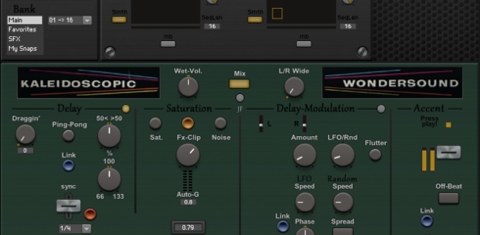
Versatile Single/Dual Echo
2.1: I managed to make the accent in millisecond mode go kaputt...fixed.
2.0:
95% redone..audio in core, controls in primary.
Many things improved. (I didn't find any mistakes in the older version)
Several things added:
-Single/dual filter (Peak/Notch/HP/BP/LP) controlled by XY pads. Movement can be recorded in sequences with quantized lenghts. (Limelite)
-Smooth operation and preset changes.
-Reverse option
-Preset-buttons
-Cpu-stress reduced
-improved sound....it's HQ.
Sample rate: The ensemble is set to 96kHz by default.
It doubles CPU-stress when the soundcard is @48kHz, but sounds much smoother (sat/dist).
Control rate: It is set to standard.
Important:
DAW use: There is no need to save a preset..everything, i
ncluding all XY-movement is saved and recalled by the DAW-project.
(The only thing causing a glitch/reset in the delay is the reverse power-button, ..which is not preset controlled)
--------
Included "showcase-ensemble":
Load up->press play->check out some presets->enjoy smooth preset changes and audio without digital harshness.
------------------------------------
Kaleidoscopic Wondersounds.
...Welcome to Stereo-Wonderland.
Single/Dual-Delay/Echo with versatile linking options, swing/shuffle, accent and classic ping-pong.
Complete interactiv design.
-Several starting-presets for analog/tape/digital character.
Possible character range: Crystal-clear to heavy (feedback-) distortion.
..Choose a preset (echo style), dial in your echo time and turn up the feedback. Voila!
View A: Fx
View B: Fx + Tips/Modes
Both: Tooltips/knob-info
Reaktor 5.9.2
---
Inspired by Soundtoys "Echoboy", Eventide "Timefactor", S-Gear "Delay-Thing" and others.
- Delay -with- sound coloration and feedback.
- Sync/milliseconds. (6 seconds delay memory)
Sync: 4/1->1/128
ms: 2sec->0ms (Mouse steps of 10 ms - shift+mouse steps of 1 ms).
- 30 sync timings.
Set by menu (if a specific timing is wanted) or fader (to dial after ear): Normal, dotted, triplet.
Including rarely used time divisions: 5/16 and 7/16. (@kemper-amps..thx)
All timings in a musical and logical order. (ordered after resulting milliseconds)
- Offset for sync and milliseconds mode:
1. A knob: 66.6%-133.3%. (Swing/Shuffle)
Offset same for both sides.
2. A knob: Left= -50% of delay L, Right= -50% of delay R.
One-sided offset. (Shift+mouse steps of 0.1%)
- Balance and feedback-balance. (Echoboy style)
- Adjustable delay response (digital->analog->f#ed up)
- Several delay modulation-sources with alot mod-headroom.
- Cutting filters + EQ/Filter-types -- frequency in Hertz (in feedback-path)
- Saturation, Noise. (in feedback-path)
- Synced pre-delay (Draggin')
Accent is a groove-feature from Echoboy.
A tremolo effect that always follows the delay-rythm.
***
Sequencers
Vss 2
by michael lancaster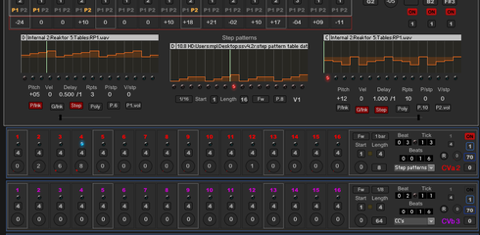
Variable Steptime Sequencer
tutorial @ http://youtu.be/iWrLPTRdhPY
***
Synthesizers
Final Softpruno
by Paule Amca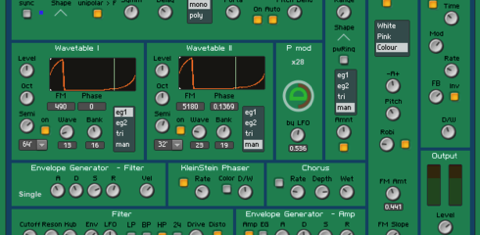
hybride synth
Some elements are lend @ SUK audio, LaZyfiSh and Rachmiel.
update in 06/2013:
- a very smal bug in the fx-way
- add envelope generator switches
- delete non-functional attack
- modified presets
- noise section from Bruno 1.1
- ringeling modulator on sub oscillator
final in 10/2014:
- a lot of more snapshots
***
KRYPTANIUM IIII VIOLIN
by Alonzo of Nezborlan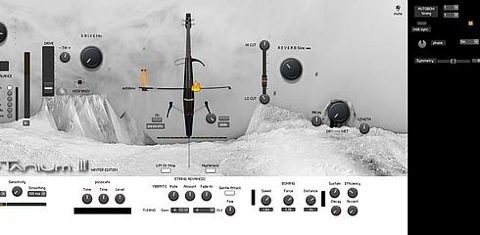
AUTOBOW WINTER EDITION
KRYPTANIUM WINTER EDITION - is a very small/simple/light mod (30%CPU) of the Serenade ensemble,
that enables it to play the bow automatically.
It has two modes so it can play in midi sync within any division of the beat, or in free time.
DAW control of Autobow parameters---> (bow speed, upper/lower range/sync etc.
This is a new feature.
It can acheive incredible results when these paramaters are automated from DAW envelopes.
It has also a cabinet wih drive and reverb from CHA-OSC.
*NOTE - It has one bug where the first note you play is too loud as the instrument loads.
INSTRUCTIONS --> start clock. run midi, or play keyboard and use the orange onscreen slider
(free mode only) to control autobow speed... or use automation.
The other 3 BOW controls:
phase/symmetry/shape are for accents to give variation while stil maintaing the bpm synced bowing speed.
All is quite obvious and labelled, but you can search out a Serenade tutorial if somethings not clear about the violin controls.
Or just ask and i can make vid overview. The great original Violin engine (Serenade) was invented by CHET SINGER.
***
MS-20 Clone (new filter)
by RobertElster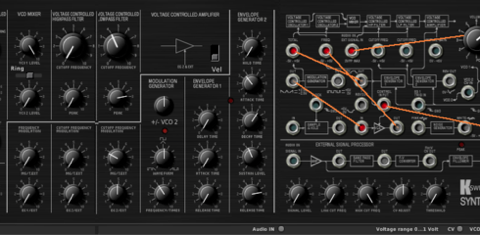
I only changed the filters so it sounds more authentic ;) Feel free to take over. I found the filter here on the ni support forums somewhere some time ago. I Can't really remember who made this, so I hope it is okay! All the credit to the dudes behind this masterpiece! SolarX, Paule Amca, Matthias Schaffner, Herwig Krass and Kristian Thom.
***
MS-X
by Matthias Schaffner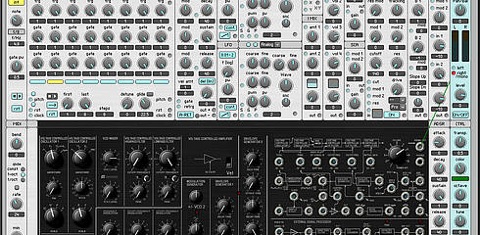
MS-20 for Modular X
The old MS-20 from Solar X in a Modular X ensemble
... one more update:
- all modulations run at audio rate now (except for triangle oscillator - can be modulated at audio rate if the switch on the bottom left is on, but doesn't have the same sound then)
- the MS-20 filters from Kristian Thom (is that right?) are also integrated now - also at audio rate.
- pitch of the sequencer can be adjusted to regular 7 note scales on panel B with a modified version of "Microtune" by Michae Kurz - the notes that are switched off get tuned down a semitone.
A few notes to the rack:
- hardwired midi interface and clock (can be accessed through the lower sequencer outputs)
- new all-in-one-VCO's (Anti-Aliased, Super (9 individual VCO's in one), FM and Wavetable)
- all-in-one Filter module with all basic reaktor filter types
- Shaper module for extra distortion
- everything is mono, so you can go from any stage directly to the output
- the different pitch out- and inputs of the MS-20 can be switched to Modular X voltage for pitch compatibility.
- Envelope Generator 2 of the MS-20 can be accessed through the SC ADSR containers "out -" when the switch is on.
Big Thanks to Herwig Krass for creating Modular X (A simple Framework for your own modular synths)
and helping out on the Forums!
Solar X for the MS-20!
Paule Amca for the skin!
Kristian Thom and Robert Elster for the alternative Filter!
You can use the ensemble as it is, or you can integrate the container into your own modular synth.
Make sure the right side is 12 steps (one row) left to the right border of your rack.
If you want to have another rack to the left of it
- fill the overlapping space with empty containers and make them invisible.
Three switches in the lower right corner let you switch input and output of Pitch to the modular X standard, so you can use it as a midi-interface or let it be run by a sequencer inside your modular - or you can activate the audio input and control everything in the modular with pitch and amplitude of an incoming audiosignal.
***
SHINE
by Brian Lake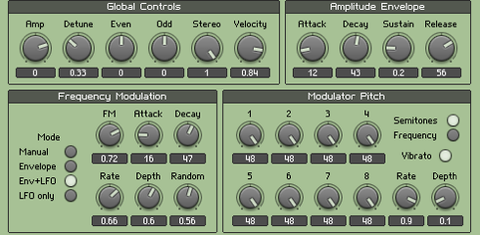
8-Voice Unisoned FM Synth with independent pitch controls!
Typical, common garden variety FM synths usually have something like 4 to 6 carrier oscillators that can behave as modulators in accordance with a pre-configured algorithm. Well, this is a bit different ...
The architecture is similar to Big Pappa, however I kept the unison voices down to 8 because each carrier has its own modulator oscillator, which makes it somewhat unique because the unison detuning happens BEFORE the detuned pitch data reaches both the carrier and it's corresponding modulator oscillator.
I find this setup eliminates the need for any chorusing effects, and has a very "shimmery" sound ... hence the name.
Also, there are independent pitch controls for each of the 8 modulator oscillators in the "Modulator Pitch" section with a nifty little option to control the modulator pitch either in semitones or linear frequency values in hertz ... as well as two pitch controls in the "Global Controls" section for even and odd numbered carrier oscillators.
The "Frequency Modulation" section has 4 modes for "Manual", "Envelope", "Envelope + LFO" and "LFO Only", plus a "Random" parameter that offsets the LFO rate for a more spontaneous attenuation of the modulator signal.
Also, I've included a slightly upgraded version of my Cloud 9 reverb, just to make your sounds ... well, you get the idea :)
***
